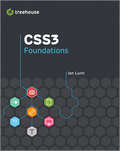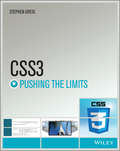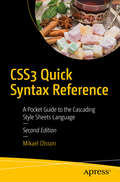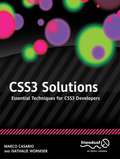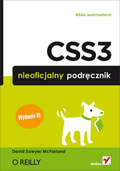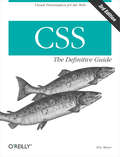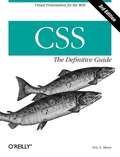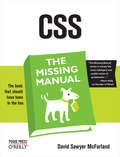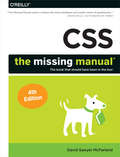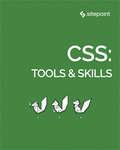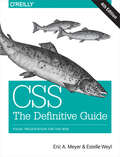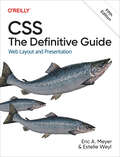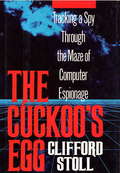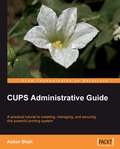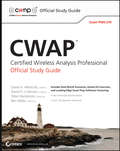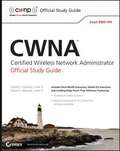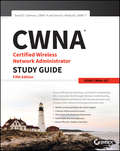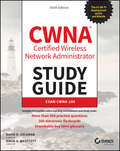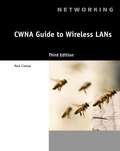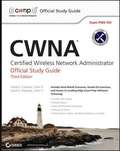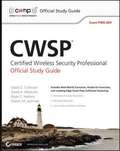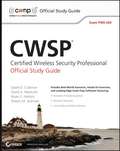- Table View
- List View
CSS3 Foundations
by Ian LunnMaster innovative and eye-catching website design with the exciting new Treehouse Series of booksTurn plain words and images into stunning websites with CSS3 and this beautiful, full-color guide. Taking web designers beyond the constraints of prebuilt themes and simple site-building tools, this new Treehouse book combines practicality with inspiration to show you how to create fully customized, modern websites that make viewers stop and stay.The exciting new Treehouse Series of books is authored by Treehouse experts and packed with innovative design ideas and practical skill-building. If you're a web developer, web designer, hobbyist, or career-changer, every book in this practical new series should be on your bookshelf.Part of the new Treehouse Series of books, teaching you effective and compelling website development and design, helping you build practical skills Provides career-worthy information from Treehouse industry pros and trainers Explains the basics of cascading style sheets (CSS), such as how to structure with CSS, use CSS syntax, how to manipulate text, and visual formatting Also covers the box model, how to animate page elements, cross-browser compatibility, and moreLeverage pages of dazzling website design ideas and expert instruction with a new Treehouse Series book.
CSS3 Pushing the Limits
by Stephen GreigPush CSS3 and your design skills to the limit--and beyond!Representing an evolutionary leap forward for CSS, CSS3 is chock-full of new capabilities that dramatically expand the boundaries of what a styling language can do. But many of those new features remain undocumented, making it difficult to learn what they are and how to use them to create the sophisticated sites and web apps clients demand and users have grown to expect.Until now.This book introduces you to all of CSS3's new and advanced features, and, with the help of dozens of real-world examples and live demos, it shows how to use those features to design dazzling, fully-responsive sites and web apps. Among other things, you'll learn how to:* Use advanced selectors and an array of powerful new text tools* Create adaptable background images, decorative borders, and complex patterns* Create amazing effects with 2D and 3D transforms, transitions, and keyframe-based animations* Take advantage of new layout tools to solve an array of advanced layout challenges--fast* Vastly simplify responsive site design using media queries and new layout modules* Create abstract and scalable shapes and icons with pseudo-elements * Leverage preprocessors and use CSS like a programming language within a stylesheet context Don't pass up this opportunity to go beyond the basics and learn what CSS3 can really do!
CSS3 Quick Syntax Reference: A Pocket Guide to the Cascading Style Sheets Language
by Mikael OlssonThe CSS3 Quick Syntax Reference is a 150-page syntax reference to the Cascading Style Sheets language. It presents the essentials of CSS3 in a well-organized format that can be used as a handy reference. You won’t find any technical jargon, bloated samples, drawn-out history lessons or witty stories in this book. What you will find is a CSS reference that is concise, to the point, and highly accessible. The book is packed with useful information and is a must-have for any CSS programmer or web developer.What You Will LearnUse the various selectors available in CSS3Leverage various other CSS propertiesDesign and build web UIs using color, text, spacing, fonts, background, and moreWork with lists, tables, and media in CSS3Employ CSS3 best practices Who This Book Is ForExperienced programmers and web developers new to CSS3 or even new to CSS in general.
CSS3 Solutions: Essential Techniques for CSS3 Developers
by Marco Casario Anselm Bradford Jonathan Reid Nathalie Wormser Dan Saltzman Francesco Improta Aaron CongletonCSS3 brings a mass of changes, additions, and improvements to CSS across a range of new modules. Web designers and developers now have a whole host of new techniques up their sleeves, from working with colors and fonts accurately, to using media queries to ensure correct styling across a multitude of devices. But all of these new technologies bring more tags to learn and more avenues for things to go wrong. CSS3 Solutions provides a collection of solutions to all of the most common CSS3 problems. Every solution contains sample code that is production-ready and can be applied to any project. What you'll learn Real-world solutions for everyday CSS3 development, saving hours of frustration. Problems covered include: Developing across multiple devices Design patterns for user experience and mobile Working with the CSS box model Who this book is for Web developers and designers seeking practical advice on making CSS3 work. Table of Contents CSS Basics CSS Selectors Font, Text and Color CSS Typography Tables and Lists CSS Box Model CSS Positioning and Layouts Multidevice Development Transitions and Transformations Multimedia and Accessibility UX Patterns Mobile UX Patterns
CSS3. Nieoficjalny podr?cznik. Wydanie III
by David Sawyer McFarlandKaskadowe arkusze stylów (ang. Cascading Style Sheets, CSS) odmieni?y ?wiat stron internetowych. Pozwoli?y oddzieli? tre?? strony od jej wygl?du. Od tej chwili ?ycie projektantów sta?o si? zdecydowanie prostsze. Praca nad zmian? wygl?du strony przesta?y przyprawia? o zawrót g?owy, a szybkie przygotowanie kilku wersji na konkretne urz?dzenia sta?o si? realne. Ostatnia wersja CSS3 wprowadza kolejne nowo?ci, które zapewni? optymalne wykorzystanie potencja?u stron WWW.Ta ksi??ka nale?y do cenionej serii „Nieoficjalny podr?cznik”. W trakcie lektury dowiesz si?, jak przygotowa? poprawny arkusz stylów i do??czy? go do strony. Poznasz najlepsze techniki formatowania konkretnych elementów kodu HTML. Ponadto przekonasz si?, ?e mo?na szybko i wygodnie zaprojektowa? profesjonaln? stron? WWW. Znajdziesz tu równie? opis nowo?ci HTML-a w wersji 5 oraz nauczysz si? korzysta? z innych czcionek ni? Arial czy Verdana. Dzi?ki CSS3 wiele operacji, które do tej pory sprawia?y k?opoty lub wymaga?y korzystania z elementów graficznych, uda Ci si? wykona? za pomoc? zaledwie paru linijek kodu. Zaokr?glone rogi, obracanie elementów, gradienty to tylko niektóre z nich. Ksi??ka ta jest obowi?zkow? lektur? dla ka?dego projektanta i webmastera chc?cego by? na bie??co z nowinkami ze ?wiata stron WWW.Poznaj sekrety CSS3!Formatowanie stronWykorzystanie niestandardowych czcionekObracanie elementówAnimacje Najlepszy przewodnik po CSS3 dla webmasterów!
CSS: The Definitive Guide
by Eric A. MeyerCSS: The Definitive Guide, 3rd Edition, provides you with a comprehensive guide to CSS implementation, along with a thorough review of all aspects of CSS 2.1. Updated to cover Internet Explorer 7, Microsoft's vastly improved browser, this new edition includes content on positioning, lists and generated content, table layout, user interface, paged media, and more.Simply put, Cascading Style Sheets (CSS) is a way to separate a document's structure from its presentation. The benefits of this can be quite profound: CSS allows a much richer document appearance than HTML and also saves time -- you can create or change the appearance of an entire document in just one place; and its compact file size makes web pages load quickly.CSS: The Definitive Guide, 3rd Edition, provides you with a comprehensive guide to CSS implementation, along with a thorough review of all aspects of CSS 2.1. Updated to cover Internet Explorer 7, Microsoft's vastly improved browser, this new edition includes content on positioning, lists and generated content, table layout, user interface, paged media, and more. Author Eric Meyer tackles the subject with passion, exploring in detail each individual CSS property and how it interacts with other properties. You'll not only learn how to avoid common mistakes in interpretation, you also will benefit from the depth and breadth of his experience and his clear and honest style. This is the complete sourcebook on CSS.The 3rd edition contains: Updates to reflect changes in the latest draft version of CSS 2.1 Browser notes updated to reflect changes between IE6 and IE7 Advanced selectors supported in IE7 and other major browsers included A new round of technical edits by a fresh set of editors Clarifications and corrected errata, including updated URLs of referenced online resources
CSS: The Definitive Guide, 3rd Edition
by Eric MeyerCSS: The Definitive Guide, 3rd Edition , provides you with a comprehensive guide to CSS implementation, along with a thorough review of all aspects of CSS 2.1. Updated to cover Internet Explorer 7, Microsoft's vastly improved browser, this new edition includes content on positioning, lists and generated content, table layout, user interface, paged media, and more. Simply put, Cascading Style Sheets (CSS) is a way to separate a document's structure from its presentation. The benefits of this can be quite profound: CSS allows a much richer document appearance than HTML and also saves time -- you can create or change the appearance of an entire document in just one place; and its compact file size makes web pages load quickly. CSS: The Definitive Guide, 3rd Edition , provides you with a comprehensive guide to CSS implementation, along with a thorough review of all aspects of CSS 2.1. Updated to cover Internet Explorer 7, Microsoft's vastly improved browser, this new edition includes content on positioning, lists and generated content, table layout, user interface, paged media, and more. Author Eric Meyer tackles the subject with passion, exploring in detail each individual CSS property and how it interacts with other properties. You'll not only learn how to avoid common mistakes in interpretation, you also will benefit from the depth and breadth of his experience and his clear and honest style. This is the complete sourcebook on CSS. The 3rd edition contains: Updates to reflect changes in the latest draft version of CSS 2.1 Browser notes updated to reflect changes between IE6 and IE7 Advanced selectors supported in IE7 and other major browsers included A new round of technical edits by a fresh set of editors Clarifications and corrected errata, including updated URLs of referenced online resources
CSS: The Missing Manual
by David Sawyer McFarlandWeb site design has grown up. Unlike the old days, when designers cobbled togetherchunky HTML, bandwidth-hogging graphics, and a prayer to make their sites look good,Cascading Style Sheets (CSS) now lets your inner designer come out and play. But CSSisn't just a tool to pretty up your site; it's a reliable method for handling allkinds of presentation--from fonts and colors to page layout. CSS: The MissingManual clearly explains this powerful design language and how you can use it tobuild sparklingly new Web sites or refurbish old sites that are ready for an upgrade.Like their counterparts in print page-layout programs, style sheets allowdesigners to apply typographic styles, graphic enhancements, and precise layoutinstructions to elements on a Web page. Unfortunately, due to CSS's complexity andthe many challenges of building pages that work in all Web browsers, most Web authorstreat CSS as a kind of window-dressing to spruce up the appearance of their sites.Integrating CSS with a site's underlying HTML is hard work, and often frustratinglycomplicated. As a result many of the most powerful features of CSS are left untapped.With this book, beginners and Web-building veterans alike can learn how to navigatethe ins-and-outs of CSS and take complete control over their Web pages'appearance.Author David McFarland (the bestselling author of O'Reilly's Dreamweaver: TheMissing Manual) combines crystal-clear explanations, real-world examples, a dashof humor, and dozens of step-by-step tutorials to show you ways to design sites withCSS that work consistently across browsers. You'll learn how to:Create HTML that's simpler, uses less code, is search-engine friendly, andworks well with CSSStyle text by changing fonts, colors, font sizes, and adding bordersTurn simple HTML links into complex and attractive navigation bars-completewith CSS-only rollover effects that add interactivity to your Web pagesStyle images to create effective photo galleries and special effects likeCSS-based drop shadowsMake HTML forms look great without a lot of messy HTMLOvercome the most hair-pulling browser bugs so your Web pages work consistentlyfrom browser to browserCreate complex layouts using CSS, including multi-column designs that don'trequire using old techniques like HTML tablesStyle Web pages for printingUnlike competing books, this Missing Manual doesn't assume that everyone in theworld only surfs the Web with Microsoft's Internet Explorer; our book providessupport for all major Web browsers and is one of the first books to thoroughlydocument the newly expanded CSS support in IE7, currently in beta release.Want to learn how to turn humdrum Web sites into destinations that will captureviewers and keep them longer? Pick up CSS: The Missing Manual and learn thereal magic of this tool.
CSS: The Missing Manual
by David Sawyer McfarlandCascading Style Sheets can turn humdrum websites into highly-functional, professional-looking destinations, but many designers merely treat CSS as window-dressing to spruce up their site's appearance. You can tap into the real power of this tool with CSS: The Missing Manual. This second edition combines crystal-clear explanations, real-world examples, and dozens of step-by-step tutorials to show you how to design sites with CSS that work consistently across browsers. Witty and entertaining, this second edition gives you up-to-the-minute pro techniques. You'll learn how to: Create HTML that's simpler, uses less code, is search-engine friendly, and works well with CSS Style text by changing fonts, colors, font sizes, and adding borders Turn simple HTML links into complex and attractive navigation bars -- complete with rollover effects Create effective photo galleries and special effects, including drop shadows Get up to speed on CSS 3 properties that work in the latest browser versions Build complex layouts using CSS, including multi-column designs Style web pages for printing With CSS: The Missing Manual, Second Edition, you'll find all-new online tutorial pages, expanded CSS 3 coverage, and broad support for Firebox, Safari, and other major web browsers, including Internet Explorer 8. Learn how to use CSS effectively to build new websites, or refurbish old sites that are due for an upgrade.
CSS: The Missing Manual (Missing Manual Ser.)
by David Sawyer McFarlandCSS lets you create professional-looking websites, but learning its finer points can be tricky—even for seasoned web developers. This fully updated edition provides the most modern and effective tips, tricks, and tutorial-based instruction on CSS available today. Learn how to use new tools such as Flexbox and Sass to build web pages that look great and run fast on any desktop or mobile device. Ideal for casual and experienced designers alike.The important stuff you need to know:Start with the basics. Write CSS-friendly HTML, including the HTML5 tags recognized by today’s browsers.Design for mobile devices. Create web pages that look great when visitors use them on the go.Make your pages work for you. Add animations that capture the imagination, and forms that get the job done.Take control of page layouts. Use professional design techniques such as floats and positioning.Make your layouts more flexible. Design websites with Flexbox that adjust to different devices and screen sizes.Work more efficiently. Write less CSS code and work with smaller files, using Syntactically Awesome Stylesheets (Sass).
CSS: Tools & Skills
by Tiffany B Brown Ahmed Bouchefra Craig BucklerCSS has grown from a language for formatting documents into a robust language for designing web applications. Its syntax is easy to learn, making CSS a great entry point for those new to programming. Indeed, it's often the second language that developers learn, right behind HTML. As CSS's feature set and abilities have grown, so has its depth. This book contains a selection fo articles that look at essential CSS tools and skills for front-end developers today. It contains: How to Use Gulp.js to Automate Your CSS Tasks by Craig BucklerCSS Optimization Tools for Boosting PWA Performance by Ahmed BouchefraCSS Debugging and Optimization: Code Quality Tools by Tiffany B. BrownCSS Debugging and Optimization: Developer Tools by Tiffany B. BrownCSS Debugging and Optimization: Minification with CSSO by Tiffany B. BrownHow to Create Printer-friendly Pages with CSS by Craig Buckler
CSS: Visual Presentation for the Web
by Eric A. Meyer Estelle WeylIf you’re a web designer or app developer interested in sophisticated page styling, improved accessibility, and saving time and effort, this book is for you. This revised edition provides a comprehensive guide to CSS implementation, along with a thorough review of the latest CSS specifications.CSS is a constantly evolving language for describing the presentation of web content on screen, printers, speech synthesizers, screen readers, and chat windows. It is used by all browsers on all screen sizes on all types of IoT devices, including phones, computers, video games, televisions, watches, kiosks, and auto consoles. Authors Eric Meyer and Estelle Weyl show you how to improve user experience, speed development, avoid potential bugs, and add life and depth to your applications through layout, transitions and animations, borders, backgrounds, text properties, and many other tools and techniques.This guide covers:Selectors, specificity, and the cascadeValues, units, fonts, and text propertiesPadding, borders, outlines, and marginsColors, backgrounds, and gradientsFloats and positioning tricksFlexible box layoutThe new Grid layout system2D and 3D transforms, transitions, and animationFilters, blending, clipping, and maskingMedia and feature queries
CSS: Web Layout and Presentation
by Eric Meyer Estelle WeylIf you're a web designer or app developer interested in sophisticated page styling, improved accessibility, and less time and effort expended, this book is for you. This revised fifth edition provides a comprehensive guide to CSS implementation along with a thorough review of the latest CSS specifications.Authors Eric Meyer and Estelle Weyl show you how to improve user experience, speed development, avoid potential bugs, and add life and depth to your applications through layout, transitions and animations, borders, backgrounds, text properties, and many other tools and techniques. We read the specs so you don't have to!This guide covers:Selectors, specificity, and the cascade, including information on the new cascade layersNew and old CSS values and units, including CSS variables and ways to size based on viewportsDetails on font technology and ways to use any available font variantsText styling, from basic decoration to changing the entire writing modePadding, borders, outlines, and margins, now discussed in terms of the new block- and inline-direction layout paradigm used by modern browsersColors, backgrounds, and gradients, including the conic gradientsAccessible data tablesFlexible box and grid layout systems, including new subgrid capabilities2D and 3D transforms, transitions, and animationFilters, blending, clipping, and maskingMedia, feature, and container queries
CUCKOO'S EGG
by Clifford StollBefore the Internet became widely known as a global tool for terrorists, one perceptive U.S. citizen recognized its ominous potential. Armed with clear evidence of computer espionage, he began a highly personal quest to expose a hidden network of spies that threatened national security. But would the authorities back him up? Cliff Stoll's dramatic firsthand account is "a computer-age detective story, instantly fascinating [and] astonishingly gripping" (Smithsonian). Cliff Stoll was an astronomer turned systems manager at Lawrence Berkeley Lab when a 75-cent accounting error alerted him to the presence of an unauthorized user on his system. The hacker's code name was "Hunter"--a mysterious invader who managed to break into U.S. computer systems and steal sensitive military and security information. Stoll began a one-man hunt of his own: spying on the spy. It was a dangerous game of deception, broken codes, satellites, and missile bases--a one-man sting operation that finally gained the attention of the CIA . . . and ultimately trapped an international spy ring fueled by cash, cocaine, and the KGB.
CUPS Administrative Guide
by Ankur ShahThis book takes a tutorial approach and each chapter contains step-wise instructions to perform specific tasks. This book is for Linux/Unix System Administrators interested in designing and setting up a CUPS network and provides enough knowledge to understand how the technology works, make decisions about deployment, and then implement a stable work environment. No knowledge in CUPS is required but readers need to be comfortable with working in the Linux/Unix environment. On the whole, readers should have basic knowledge of the Linux environment.
CWAP Certified Wireless Analysis Professional Official Study Guide
by David A. Westcott David D. Coleman Ben Miller Peter MackenzieThe official study guide for the Certified Wireless Analysis Professional certification from CWNPFour leading wireless experts thoroughly prepare you for the vendor-neutral CWAP exam administered by CWNP, the industry leader for enterprise Wi-Fi training and certification. This official study guide not only covers all exam objectives for the CWAP exam, it also prepares you to administer and troubleshoot complex enterprise WLAN environments.Covers all exam objectives for the Certified Wireless Analysis Professional (CWAP) examCovers 802.11 physical (PHY) and 802.11 MAC layer frame formats and technologiesAlso covers 802.11 operation and frame exchanges, spectrum analysis and troubleshooting, and protocol analysis and troubleshootingIncludes hands-on exercises using the Wireshark protocol analyzer and Fluke Network's Spectrum analyzer softwareCompanion CD includes two practice exams and over 150 electronic flashcardsAdvancing your skills as a wireless administrator professional? Start by passing the CWAP exam with the complete test prep you'll find in this practical study guide and CD.Note: CD-ROM materials for eBook purchases can be downloaded from http://booksupport.wiley.com.
CWDP® Certified Wireless Design Professional
by Shawn M. Jackman Matt Swartz Marcus Burton Thomas W. HeadThe official study guide for the Certified Wireless Design Professional (CWDP) exam from CWNP! This official guide is what you need to prepare for the vendor-neutral CWDP exam (PW0-250), which tests an IT professional's ability to design, plan, and troubleshoot a wireless network. Administered by CWNP, the industry leader for enterprise Wi-Fi training and certification, the CWDP exam is for those operating in large WLAN deployments. This practical guide not only covers all exam objectives, it also gives you practical information on designing for complex environments such as businesses, hospitals, educational facilities, and in outdoor spaces. Covers all exam objectives for the Certified Wireless Design Professional (CWDP) exam, exam PW0-250 Covers planning, developing a WLAN design strategy and RF, conducting advanced site surveying, developing 802. 11 security, and troubleshooting Companion CD includes two practice exams and over 100 electronic flashcards Sybex is the official publisher for Certified Wireless Network Professional, Inc. , the certifying vendor for the CWAP program If you want to prepare for CWNP certification, a Sybex Study Guide is what you need! Note: CD-ROM materials for eBook purchases can be downloaded from http://booksupport. wiley. com.
CWNA Certified Wireless Network Administrator Official Study Guide
by David A. Coleman David D. WestcottSybex is now the official publisher for CWNP, the certifying vendor for the CWNA program. This valuable guide covers all objectives for the newest version of the PW0-104 exam, including radio technologies; antenna concepts; wireless LAN hardware and software; network design, installation and management; wireless standards and organizations; 802. 11 network architecture; wireless LAN security; performing site surveys; and troubleshooting. Also included are hands-on exercises, chapter review questions, a detailed glossary, and a pre-assessment test. The CD-ROM features two bonus exams, over 150 flashcards, and numerous White Papers and demo software. Note: CD-ROM materials for eBook purchases can be downloaded from CWNP's website at www. cwnp. com/sybex.
CWNA Certified Wireless Network Administrator Study Guide: Exam CWNA-107
by David A. Westcott David D. ColemanThe bestselling CWNA study guide, updated for the latest exam The CWNA: Certified Wireless Network Administrator Study Guide is the ultimate preparation resource for the CWNA exam. Fully updated to align with the latest version of the exam, this book features expert coverage of all exam objectives to help you internalize essential information. A pre-assessment test reveals what you already know, allowing you to focus your study time on areas in need of review, while hands-on exercises allow you to practice applying CWNA concepts to real-world scenarios. Expert-led discussion breaks complex topics down into easily-digestible chucks to facilitate clearer understanding, and chapter review questions help you gauge your progress along the way. You also get a year of free access to the Sybex online interactive learning environment, which features additional resources and study aids including bonus practice exam questions. The CWNA exam tests your knowledge of regulations and standards, protocols and devices, network implementation, security, and RF site surveying. Thorough preparation gives you your best chance of passing, and this book covers it all with a practical focus that translates to real on-the-job skills. Study 100% of the objectives for Exam CWNA-107 Assess your practical skills with hands-on exercises Test your understanding with challenging chapter tests Access digital flashcards, white papers, bonus practice exams, and more The CWNA certification is a de facto standard for anyone working with wireless technology. It shows employers that you have demonstrated competence in critical areas, and have the knowledge and skills to perform essential duties that keep their wireless technology functioning and safe. The CWNA: Certified Wireless Network Administrator Study Guide gives you everything you need to pass the exam with flying colors.
CWNA Certified Wireless Network Administrator Study Guide: Exam CWNA-108
by David A. Westcott David D. ColemanThe #1 selling Wi-Fi networking reference guide in the world The CWNA: Certified Wireless Network Administrator Study Guide is the ultimate preparation resource for the CWNA exam. Fully updated to align with the latest version of the exam, this book features expert coverage of all exam objectives to help you pass the exam. But passing the exam is just a first step. For over 16 years, the CWNA Study Guide has helped individuals jump-start their wireless networking careers. Wireless networking professionals across the globe use this book as their workplace reference guide for enterprise Wi-Fi technology. Owning this book provides you with a foundation of knowledge for important Wi-Fi networking topics, including: Radio frequency (RF) fundamentals 802.11 MAC and medium access Wireless LAN topologies and architecture WLAN design, troubleshooting and validation Wi-Fi networking security The book authors have over 40 years of combined Wi-Fi networking expertise and provide real-world insights that you can leverage in your wireless networking career. Each of the book’s 20 chapters breaks down complex topics into easy to understand nuggets of useful information. Each chapter has review questions that help you gauge your progress along the way. Additionally, hands-on exercises allow you to practice applying CWNA concepts to real-world scenarios. You also get a year of free access to the Sybex online interactive learning environment, which features additional resources and study aids, including bonus practice exam questions. The CWNA certification is a de facto standard for anyone working with wireless technology. It shows employers that you have demonstrated competence in critical areas, and have the knowledge and skills to perform essential duties that keep their wireless networks functioning and safe. The CWNA: Certified Wireless Network Administrator Study Guide gives you everything you need to pass the exam with flying colors.
CWNA Guide To Wireless LANs
by Mark CiampaCWNA GUIDE TO WIRELESS LANS, 3rd Edition provides you with the conceptual knowledge and hands-on skills needed to work with wireless technology in a network administration environment as well as pass the Certified Wireless Network Administrator (CWNA) exam. The text covers fundamental topics, such as planning, designing, installing, securing, and configuring wireless LANs. It also details common wireless LAN uses including maintenance, security, and business applications. The third edition is designed around the latest version of the CWNA exam, as well as the new IEEE 802. 11 standard, making CWNA GUIDE TO WIRELESS LANS the practical guide that prepares you for real-world wireless networking.
CWNA: Certified Wireless Network Administrator Official Study Guide
by David A. Westcott David D. ColemanUpdated edition of this top-selling CWNA study guideSybex is the official publisher for CWNP, Inc., the organization behind the the CWNA certification. The new edition of Sybex's top-selling CWNA Study Guide covers the latest CWNA Exam, PW0-105. If you're preparing for the exam, you'll find full coverage of radio frequency (RF) technologies, as well as IEEE 802.11 regulations and standards, protocols and devices, network security, and much more. This detailed book not only covers all exam objectives, it also includes practical chapter review questions and hands-on exercises. The book's website offers additional practice exams and flashcards, demo software, and more.Prepares you for Exam PW0-105, the new CWNA exam administered by the Certified Wireless Network Professional, Inc.Covers all exam objectives, including radio frequency (RF) technologies and IEEE 802.11 regulations and standards, protocols and devices, network implementation, network security, and RF site surveyingIncludes practical examples and review questions to reinforce learningDiscusses the latest information on wireless trends, protocols, and standards--helpful whether you're preparing for the exam or notProvides additional practice exams, electronic flashcards, demo software, and more from the book's accompanying websiteCWNA certification is the foundation for any professional who uses wireless networks--and a springboard to more advanced wireless certifications. Get started today with this detailed CWNA prep guide.Note: CD-ROM materials for eBook purchases can be downloaded from http://booksupport.wiley.com.
CWSP Certified Wireless Security Professional Official Study Guide
by David A. Westcott David D. Coleman Shawn M. Jackman Bryan E. HarkinsSybex is now the official publisher for Certified Wireless Network Professional, the certifying vendor for the CWSP program. This guide covers all exam objectives, including WLAN discovery techniques, intrusion and attack techniques, 802.11 protocol analysis. Wireless intrusion-prevention systems implementation, layer 2 and 3 VPNs used over 802.11 networks, and managed endpoint security systems. It also covers enterprise/SMB/SOHO/Public-Network Security design models and security solution implementation, building robust security networks, wireless LAN management systems, and much more.
CWSP: Certified Wireless Security Professional
by David A. Westcott David D. Coleman Shawn M. Jackman Bryan E. HarkinsSybex is now the official publisher for Certified Wireless Network Professional, the certifying vendor for the CWSP program. This guide covers all exam objectives, including WLAN discovery techniques, intrusion and attack techniques, 802. 11 protocol analysis. Wireless intrusion-prevention systems implementation, layer 2 and 3 VPNs used over 802. 11 networks, and managed endpoint security systems. It also covers enterprise/SMB/SOHO/Public-Network Security design models and security solution implementation, building robust security networks, wireless LAN management systems, and much more.
CWSP: Exam CWSP-205
by David A. Westcott David D. Coleman Bryan E. HarkinsThe most detailed, comprehensive coverage of CWSP-205 exam objectives CWSP: Certified Wireless Security Professional Study Guide offers comprehensive preparation for the CWSP-205 exam. Fully updated to align with the new 2015 exam, this guide covers all exam objectives and gives you access to the Sybex interactive online learning system so you can go into the test fully confident in your skills. Coverage includes WLAN discovery, intrusion and attack, 802.11 protocol analysis, wireless intrusion prevention system implementation, Layer 2 and 3 VPN over 802.11 networks, managed endpoint security systems, and more. Content new to this edition features discussions about BYOD and guest access, as well as detailed and insightful guidance on troubleshooting. With more than double the coverage of the "official" exam guide, plus access to interactive learning tools, this book is your ultimate solution for CWSP-205 exam prep. The CWSP is the leading vendor-neutral security certification administered for IT professionals, developed for those working with and securing wireless networks. As an advanced certification, the CWSP requires rigorous preparation -- and this book provides more coverage and expert insight than any other source. Learn the ins and outs of advanced network security Study 100 percent of CWSP-205 objectives Test your understanding with two complete practice exams Gauge your level of preparedness with a pre-test assessment The CWSP is a springboard for more advanced certifications, and the premier qualification employers look for in the field. If you've already earned the CWTS and the CWNA, it's time to take your career to the next level. CWSP: Certified Wireless Security Professional Study Guide is your ideal companion for effective, efficient CWSP-205 preparation.
